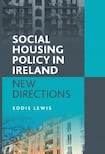
When a former senior official from the Department of Environment writes a book about social housing we should all sit up and take note.
Eddie Lewis spent three decades working in the Custom House and was the driving force behind many of key housing policy reforms before his retirement in 2014. Since leaving the department he has run the professional diploma in housing studies at the Institute of Public Administration.
At the launch of his book in the Custom House, the current secretary general of the department, John McCarthy, told of the frequent early-morning visits which Lewis would make to his office having spent the entire night thinking through a problem.
Eddie would loiter at his line manager’s door with a “glint in his eye” and say “John…I have an idea”. McCarthy would reply, only half jokingly, “now we have trouble”. But the persistent principal officer would return to the idea again and again until it was eventually heard.
The story reveals two interesting things: a department whose culture is not accustomed to policy specialists thinking through and solving problems with “new ideas” and a public servant with an incredibly active mind and a desire to address problems even if it means innovating and pushing back against the traditional way of doing things.
So not surprisingly, this is the central thrust of Lewis’s book: the story of an unsuccessful attempt to reform the delivery of social housing during the 2000s.
Before then, Lewis argues, social housing delivery had remain broadly unchanged since the foundation of the state. The system was defined by large council estates; low levels of rent; poor maintenance of existing stock; generous discounts for tenant purchase; fluctuating levels of capital investment in new builds; limited choice for tenants; and lack of consistency in service delivery across local authorities.
From the late 1990s, and particularly following the Housing (Miscellaneous Provisions) Act 2009, officials in the department, including Lewis, sought to implement what they called the Social Housing Reform Agenda.
At the centre of this agenda was a “rejection of the idea of a ‘house for life’ as the basis for social housing” policy. In its place would be a variety of “social housing supports” which would provide greater “choice for consumers”.

The idea of large council estates was to be rejected in favour of mixed tenure “sustainable communities”. There was a commitment to ending the privileging of owner occupation in favour of tenure neutrality. Housing-led responses to homelessness were to replace the old emergency accommodation system.
The reform agenda was heavily influenced by the 2005 National Economic and Social Council report, The Developmental Welfare State. That report called for greater flexibility and choice in the delivery of public services to better meet the needs of people as they move through their “life cycle”.
Signature policies from the agenda that were implemented included Choice Based Lettings, allowing tenants to pick their own homes, and the Housing Assistance Payment, subsidising social housing tenants to live in the private rental sector. Others, such as reform of differential rent and ending tenant purchase, never saw the light of day.
Ultimately Lewis’s reforms were thwarted by political, departmental and economic factors. However, in his view the problems remain the same and the need for reform is now greater than ever.
At the book’s conclusion Lewis outlines three future pathways for the social housing sector. While the detail is too great to recount here they amount to a revised version of the traditional model; a radical change of direction; or a reform agenda somewhere between the two.
While one gets the sense that Lewis would prefer the radical change of direction, ever the civil servant operating within the constraints of political and fiscal reality, he veers towards the third option. His main caution, however, is that things can not remain the same.
Unsurprisingly there are many aspects of Social Housing Policy in Ireland: New Directions that I strongly disagree with.
My reading of the history of social housing is very different from Lewis’s, with 1987 marking the real break with the past. The reform agenda that was introduced from that point on – financialisation of owner occupation as private credit became the main source of home finance and residualisation of social housing and council housing for working people became welfare housing for the very poor – was both successful and deeply detrimental to our entire housing system.
The dogma of mixed-tenure sustainable communities flies in the face of decades of evidence that supports well-planned large-scale social housing developments by academics such as Tony Fahey, Michelle Norris and Cathal O’Connell.
And the shift from “bricks to benefits” (to borrow a phrase from the English housing policy analyst Anna Minton) represented by short term supports such as HAP represents the “casualisation” of social housing rather than greater life cycle choice.
However, there is much in Lewis’s options for the future that I fully support including; the need for tenure neutrality in government housing policy; the value of affordable rental accommodation; and the importance of giving working-class families real choice in their housing options.
Every single page of Social Housing Policy in Ireland: New Directions is packed with ideas. At times it reads more like Lewis's own thought processes as he works through the problems rather than his own settled point of view. It is a challenging but without doubt rewarding read. It should be read widely and in particular by those politicians and civil servants who are deciding the present and future of our social housing system.
Eoin Ó Broin TD is Sinn Féin's spokesperson on Housing, Planning and Local Government and author of Home: why public housing is the answer, just published by Merrion Press, 2019









